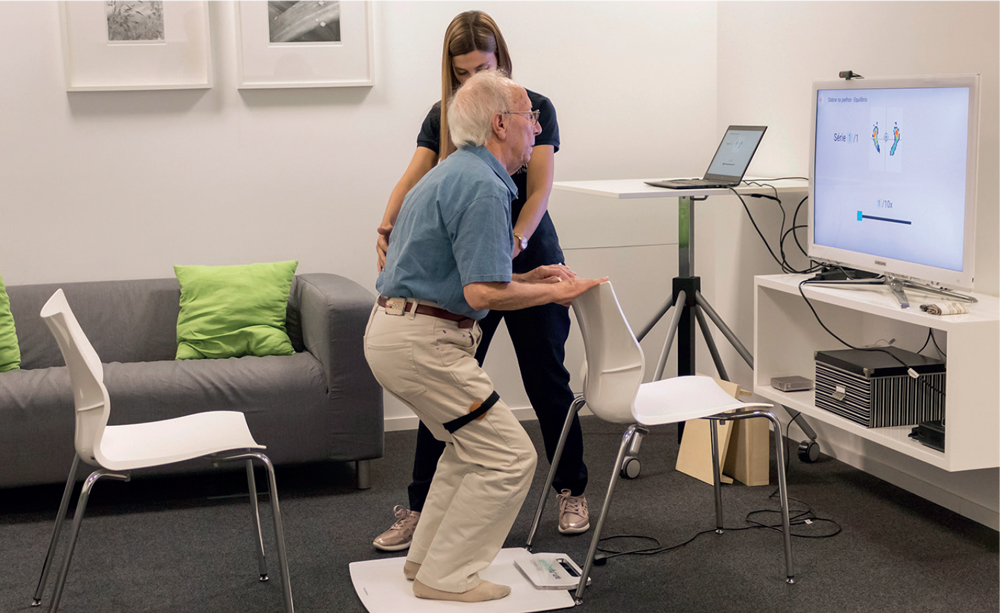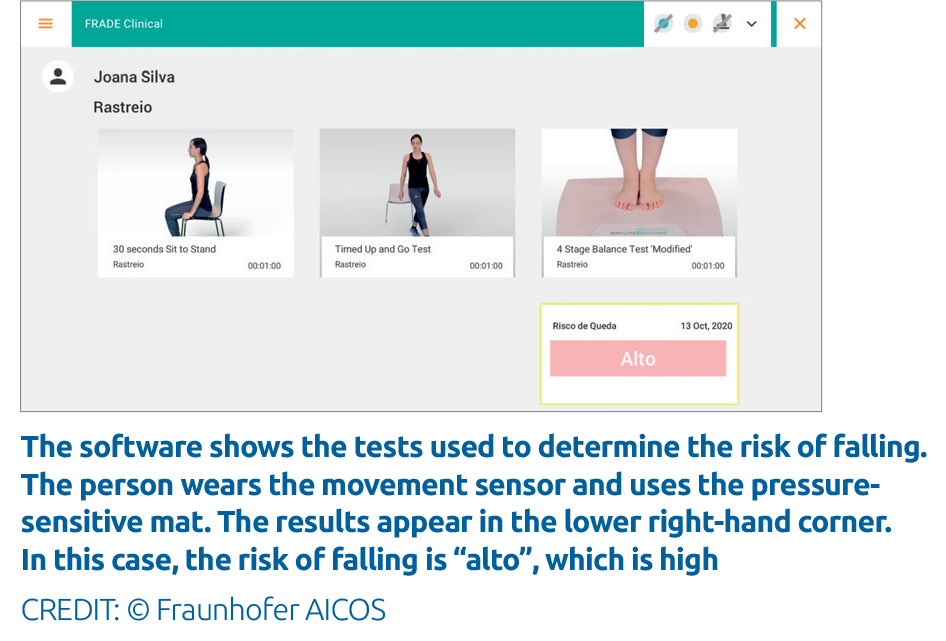Innovative FRADE project improves fall prevention for the elderly
Senior citizens who are a little weaker or frail are often prone to falling. The FRADE concept of the Fraunhofer Center AICOS in Porto, Portugal offers effective help with prevention. Sensor-based analysis of movements serves as a basis for a tailored training program. If the person actually falls, the system alerts the caregiver via text message. International Hospital reports.
Many older and frail people live with the risk of falling in their home and then possibly waiting hours for assistance, which is often a persistent fear for their families. This is also a problem for caregiversw ho visit their patients daily, but know that they will be unsupervised for several hours.
The Fraunhofer Center for Assistive Information and Communication Solutions (AICOS) in Porto, Portugal, developed the FRADE project specifically for this problem. FRADE stands for “pervasive platform for fall risk assessment, fall detection and fall prevention”. The central component is a sensor that is attached to the clothing. If the person wearing the sensor falls down, an alert is sent to the caregiver via text message. But this is just one part of the multistep concept.
“We want to prevent people from falling in the first place,” explains Project Manager Joana Silva.
Analysis of movements, assessment of the risk of falling
The first step in the FRADE concept is to assess the elderly or frail person’s risk of falling with a series of tests that analyse the person’s typical movements. Under the supervision of a therapist, the person performs various movements, which can include getting up from a chair, walking a few meters, and standing still, with each exercise repeated several times. An acceleration sensor attached to the ankle or the waist registers movements and sends the data via Bluetooth Low Energy (BLE) to a desktop computer.
A pressure-sensitive mat that measures the distribution of bodyweight on the soles of the feet is also used for certain exercises. A large display shows plantar pressure distribution as a graph in real time. The system is able to detect if pressure is applied to the feet unevenly – for example, when the person bends their knees – which may be an indication of balancing issues. The mat sends this measurement data to the computer via USB, where it is analysed by software equipped with specific algorithms.
“All of the data is compiled to create an individual movement profile, which we can use to determine the person’s risk of falling. That is one of the FRADE innovations,” explains Silva. All of the information finds its way to the back-end server, which also serves as a central data storage platform for caregivers.
The tailored training program for home
In the second step, the person is provided with a kit consisting of a sensor and Android tablet as well as a training program for home that is tailored to their individual movement profile and risk of falling. The training app shows in graphic form how to perform the movements. Once again, the wearable inertial sensor analyses the movements. A microprocessor integrated into the sensor processes all of the data and sends it to the tablet via BLE. Those who train on a regular basis – i.e. around two to three times a week – can isgnificantly reduce their risk of falling after a period of at least eight weeks.
The person is not entirely on their own as they do the exercises, as the Android app sends the data to the web server via theapartment’s Internet connection. Caregivers and therapy specialists thus have access to their client’s training data, which is visualized for them. If necessary, they can intervene and provide support.
Alert sent via text message after a fall
Users should wear the sensor throughout the day for their own safety. The small device can be conveniently attached to the clothing with a clip. If the person does fall despite the training, the sensor sends an alert to the web server via Narrowband Internet of Things (NB-IoT). NB-IoT is an energy-saving radio technology optimized for small data volumes and can be integrated into existing cellular networks. If NB-IoT is not supported, the sensor module simply uses traditional GSM technology. Once the web server receives the alert, it sends a text message to the caregiver, who then knows who exactly has fallen and needs help.
A key benefit of FRADE is that it brings together the different aspects associated with the risk of falling among the elderly.
“We combine different tasks: analysis of the risk of falling, prevention through training and the text message alert after a fall – all of these tasks are integrated seamlessly into a single platform,” says Silva. This is why FRADE also benefits hospitals, doctor’s offices, therapy centres and care providers.
FRADE offers yet another advantage: it decentralizes care and support, since people can do their exercises at home.
The AICOS team has been working on this concept since 2015. “We’ve already analysed the movements of more than 400 volunteers and developed tailored training programs in collaboration with therapists,” explains Silva. To make the sensor and app more user-friendly for the target group, AICOS is planning usability tests with 25 women and men in the coming months.
Use on the go with GPS
Fraunhofer researchers developed both the Android app and the desktop software, while AICOS experts defined the specifications for the wearable device. The University of Porto and the nursing school Escola Superior de Enfermagem do Porto also participated in the project. The European Union supported the project coordinated by AICOS with €75,000 through the EIT Health RIS Innovation Call funding program.
In the next phase, the centre in Porto will work on validating the system for use on the go. The sensor could also accompany senior citizens when they go shopping or for a walk. If the sensor registers a fall, it transmits the data to the web server and supplies the position via GPS.
Music can reduce anxiety amongst elderly during Covid vaccinations
Care providers should play music during the administration of coronavirus vaccinations to reduce feelings of anxiety in the elderly, researchers have said.
Research by Birmingham City University academic Mark Brill with Pendine Park Care Homes in Wales found that using music at the point of care can reduce stress, particularly for those living with dementia.
“Our research with care homes has shown how powerful music is in supporting people living with dementia, making care tasks easier, so it feels like a natural extension to use it during vaccinating,” explained Mark Brill, a senior lecturer in digital innovation at Birmingham City University.
Brill worked alongside Manchester Metropolitan University’s Dr Stuart Cunningham and Dr Harry Whalley from the University for the Creative Arts in the wellbeing study.
Through published research, the team have shown that playing appropriate music during care activities can have a significant impact in managing anxiety and agitation and make care easier to provide.
The peer reviewed ‘Memory Tracks’ study showed that memorable songs can ‘cut-through’ anxiety, open up communication and create a relaxed atmosphere where effective care can take place.
“Care homes are under increased pressures, yet something as simple as music can bring relief all-round,” added Mark.
“We have prepared guides and support materials which would help make it easy for care staff and clinicians to use the technology during the vaccination process.”
Reference
Assessing Wellbeing in People Living with Dementia Using Reminiscence Music with a Mobile App (Memory Tracks): A Mixed Methods Cohort Study. Journal of Healthcare Engineering. 5 Sep 2019. doi: https://doi.org/10.1155/2019/8924273



